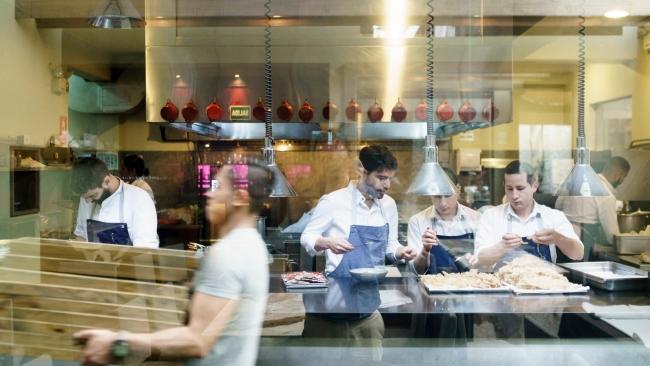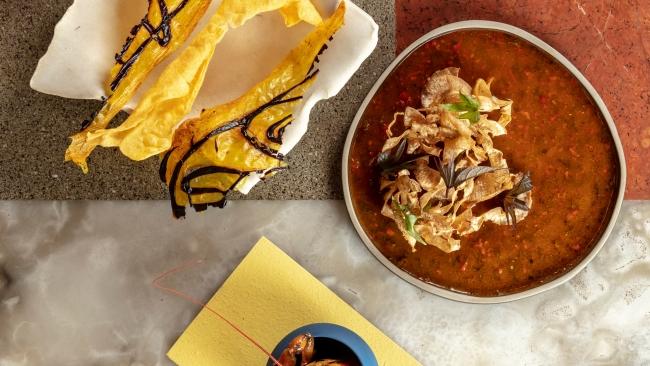I ate at the world's best restaurant, here's my honest review
“Smelled like Band-Aids”: This Australian traveller reveals his verdict on a confronting meal he was served at the restaurant rated the best on the planet.

Lifestyle
Don't miss out on the headlines from Lifestyle. Followed categories will be added to My News.
Last month, in Valencia, the winners of the 2023 World’s 50 Best Restaurants were announced. For those who travel to eat – which is all of us, more or less – the awards are an annual tip sheet to the most exceptional tables on Earth. Or so the promoters would have us believe.
This year was a strange list, I thought (as someone who once helped judge the awards). The host nation, Spain, received six placings, which isn’t so surprising given Spanish cuisine has been all the rage since El Bullí dominated the early 2000s, winning the World’s Best Restaurant title a record five times.
In 2023 the crown went to Central in Lima, Peru. I have no beef with Central – besides the calf’s heart I was served there once – but was amazed it was one of 12 entries from Latin America in a supposedly global list.
Having more than a third of the finalists come from the Spanish-speaking world seemed weirdly indulgent and tone-deaf, especially considering there were precisely none from the continents of Africa or Australia.
Glaring omissions aside, Central is not a bad choice. And it’s about time Latin America – home to such groundbreaking gastronomic experiences as Mexico City’s Pujol (ranked 13 in 2023), Boragó in the Chilean capital, Santiago (number 29), and Lima compatriot Maido (more on which in a bit) – triumphed.

I’ve eaten at Central and, while it’s certainly not for everyone, it definitely ticks the World’s 50 Best obsessions with creative, thoughtful, hyperlocal, novel and theatrical gastronomy. And if you like to be thrilled by new sensations, it delivers. Some of the dishes served there are actually incredible.
Central is the very essence of Peru. The restaurant’s research arm, Mater Iniciativa, mines the country’s intense biodiversity to create menus showcasing its bounty of indigenous produce.
Chefs Virgilio Martínez and Pía Léon arrange ingredients vertically, creating ecosystems on a plate. Their multi-course Mater Elevations menu generally starts with a dish of things harvested under the sea, usually seaweed and some sort of clam, perhaps with some crab and/or sea snail.
Mine was served on a porous green rock and seasoned with dried marine herbs. The textures were diverse, the flavour was full-on umami and afterwards all I could taste was the ocean. It was paired with a bottle of lettuce and lime juice, which looked like brackish water but was surprisingly pleasant. A bit sweet, grassy, refreshing.

At the other altitude extreme, I ate a dish sourced from 1880m in the “Low Andes” that involved the aforementioned veal heart, dehydrated and shaved, with vibrantly coloured quinoa seeds and a milk of Andean herbs, which I was not mad about.
The dish married classical French technique with distinctly Peruvian ingredients, so while I could appreciate the cooking (especially the rich, sticky jus), I wasn’t always sold on the flavours (the airampo prickly pear in the milk smelled like Band-Aids).
Much of the meal involved me putting things in my mouth for the first time.
Things like olluco, a pretty pink and yellow potato that grows above 2000m; tumbo, a type of passionfruit; the latex-like sap of the dragon’s blood tree; gamitana fish (piranha cousins) and river snails (unexpectedly delicious). Plus pijuayo, huito, kiwicha and bahuaja nut.
If you do get to Lima, which is both edgy and elegant, and a handy gateway to the Amazon and the Andes, book a table at Central by all means. But dine, too, at Kjolle, Pía León’s more casual upstairs eatery (number 28 this year), and maybe also at newcomer Mayta (number 47).

And don’t miss Maido, currently the sixth best restaurant in the world. That rating could be debated, but anyone who loves great, surprising food won’t be disappointed.
Chef Mitsuharu Tsumura showcases the city’s unique Nikkei cuisine, a blend of Japanese gastronomy and Peruvian ingredients.
You might not recognise the term Nikkei, but if you’ve ever eaten a ceviche-like tiradito, the raw-fish dish “cured” with leche de tigre spicy citrus juice, you’ve tasted it. Other notable Maido fusions: Amazon snails slicked with yuzu foam, and short ribs braised for two days in soy, sake and mirin.
As chef Micha likes to say, Peruvian is hard rock, Japanese is classical, but together they make beautiful music. And honestly, his guinea-pig dish – called Mr Guinea Pig (Cuy San or Señor Cuy) and served deboned, confited in duck fat and smeared in cassava cream – is a showstopper. Almost worth a trip to Lima on its own.
WHAT ABOUT AUSTRALIA?
No Australian restaurants in the top 50? That can only mean one thing: not enough World’s 50 Best judges ate here during the 18-month voting period. Perhaps Tourism Australia could invite some influential gastronomes to come dine Down Under?
Originally published as I ate at the world's best restaurant, here's my honest review





